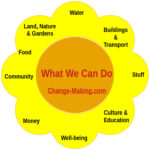Drop Yer Bloomers
Lately I’ve been growing impatient with impatiens. Petunias, snapdragons, bouganvilla, ficus, bird-of-paradise: our Southern California cities luxuriate in year-round ornamental gardens. Pretty bloomers, yes. But truly, a mix of non-functional tropical plants slurping water in what is really a desert climate, usurping land use where urban space is now so precious.
Lawns and nonfunctional landscapes are a haughty scoff: “I don’t NEED to produce food.” Historically, these ornamental gardens and sweeping lawns originated with the emergence of the middle class and their desire to imitate the estates of the nobility. (Sweeping lawns were maintained around the castles of old for military purposes, so that they could see and kill enemy soldiers.)
“I don’t NEED to produce food” is an ostentatious attitude: I am above it all, it declares. I will be dependent upon someone else for my basic sustenance. I can transcend the basic critter-need of finding nourishment. I can detach myself from the system of life and rely on processed, deadened products from the supermarket that come in colorful printed boxes or wrapped in non-biodegradable polystyrene and saran.
By declaring “I don’t NEED to produce food,” we are perpetuating a dependency on a national food production system which is deeply flawed with respect to soil resources, biodiversity and chemical inputs. A system which is irretrievably dependent upon exhaustible, polluting, greenhouse-gas-emitting petroleum products.
In the 1930s and 1940s nearly 20 million Americans turned to their gardens in support of that war effort. Called “Victory Gardens,” these backyard cultivations produced nearly 40% of the produce that was consumed. Yet those gardens grew more than just vegetables. Those gardens grew resilience, determination, and self-reliance. They were an active way to participate in the solutions to world problems.
We gardeners have learned the intimate satisfaction of burying our fingers in the rich earth as we provide what a plant needs to flourish. We have experienced the thrill of harvesting the first richly scented tomato, softened and warmed by the sun. Those inner feelings of satisfaction and thrill are empowering; we have achieved something. That tomato nourishes not just our belly, it nourishes our spirit.
We have discovered the visual beauty of the purple blossoms of Carouby de Maussane snowpeas, the scarlet-veined bouquets of rainbow chard, and the cheery chatter of multicolored sunflowers, all the while growing food for our bodies. Those of us in condos or apartments have learned that most edibles can be grown in containers. Forward-thinking gardeners are now realizing that the tree they choose to shade their yard from summer’s intensity could be one that yields sweet navel oranges the next winter.
By growing our own, we boost our health through organics. We foster biodiversity by raising heirloom varieties. We reap all the benefits of the local food movement: seasonal, vine-ripened food; reduced dependency on agricultural conglomerates; lowered pollution and greenhouse gas emissions from transport.
In this time of environmental upheaval, glacial melting, wildlife extinctions, forest destruction, furious hurricanes, escalating gas prices, and crumbling economy, we gardeners have found one unifying, rallying cry: We DO need to produce food. Clean food for our bodies, empowerment for our spirits, renewal for the earth. We need this very different sort of victory.
Our spirits need it, because it is tangible evidence that environmental transformation is real and is possible. Our bodies need it, because we can grow healthier at home. Our earth needs it, because in its seeds are restoration, political statement, environmental action, activism, and ultimately, victory.
Try it. Drop yer bloomers and try edibles. Just one small pot on a balcony. One small corner of your yard. Start small. One herb, one vegetable, or perhaps an ultra-dwarf fruit tree. Re-establish the connection. And reap the victory.
Return to Table of Contents

